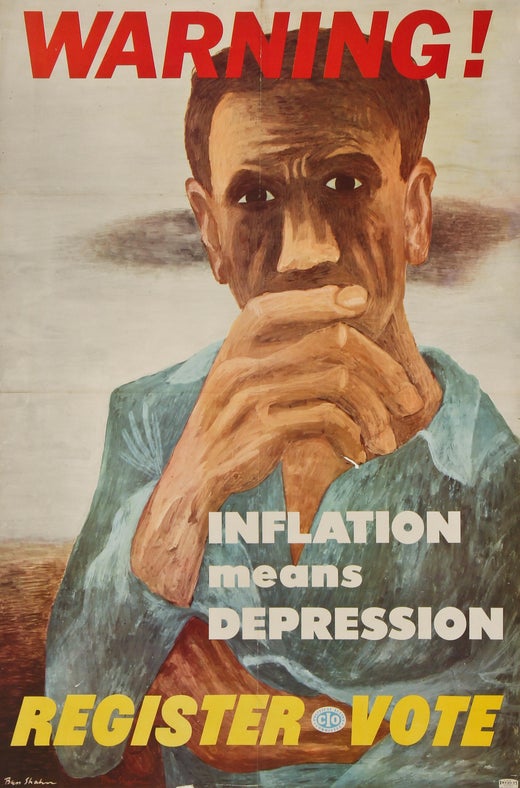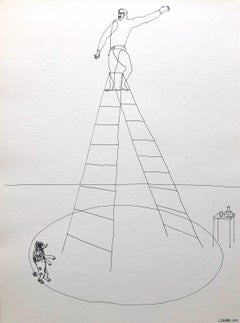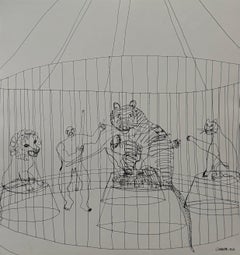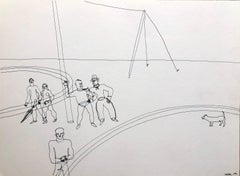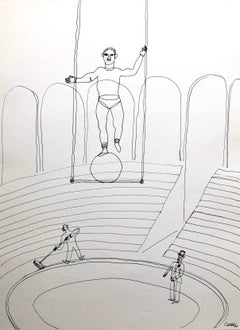Want more images or videos?
Request additional images or videos from the seller
1 of 9
Ben ShahnBen Shahn Original Hand Signed Litho WPA Artist Rilke Poem Lithograph Portfolio1968
1968
$2,800List Price
About the Item
- Creator:Ben Shahn (1898-1969, American)
- Creation Year:1968
- Dimensions:Height: 30 in (76.2 cm)Width: 25 in (63.5 cm)
- Medium:
- Movement & Style:
- Period:
- Condition:minor wear. even toning to paper, needs new mat. please see photos.
- Gallery Location:Surfside, FL
- Reference Number:1stDibs: LU3826218282
Ben Shahn
Ben Shahn (1898 – 1969) was a Lithuanian-born American artist. He is best known for his works of social realism, his left-wing political views, and his series of lectures published as The Shape of Content. Shahn began his path to becoming an artist in New York, where he was first trained as a lithographer. Shahn's early experiences with lithography and graphic design is apparent in his later prints and paintings which often include the combination of text and image. Shahn's primary medium was egg tempera, popular among social realists. Shahn mixed different genres of art. His body of art is distinctive for its lack of traditional landscapes, still lifes, and portraits. Shahn used both expressive and precise visual languages, which he coalesced through the consistency of his authoritative line. Shahn is also noted for his use of unique symbolism, which is often compared to the imagery in Paul Klee's drawings. His art is striking but also introspective. He often captured figures engrossed in their own worlds. Although he used many mediums, his pieces are consistently thoughtful and playful.
About the Seller
4.9
Platinum Seller
Premium sellers with a 4.7+ rating and 24-hour response times
Established in 1995
1stDibs seller since 2014
1,833 sales on 1stDibs
Typical response time: 1 hour
Authenticity Guarantee
In the unlikely event there’s an issue with an item’s authenticity, contact us within 1 year for a full refund. DetailsMoney-Back Guarantee
If your item is not as described, is damaged in transit, or does not arrive, contact us within 7 days for a full refund. Details24-Hour Cancellation
You have a 24-hour grace period in which to reconsider your purchase, with no questions asked.Vetted Professional Sellers
Our world-class sellers must adhere to strict standards for service and quality, maintaining the integrity of our listings.Price-Match Guarantee
If you find that a seller listed the same item for a lower price elsewhere, we’ll match it.Trusted Global Delivery
Our best-in-class carrier network provides specialized shipping options worldwide, including custom delivery.You May Also Like
Prodigal Son
By Thomas Hart Benton
Located in London, GB
A man raises his hand to his chin, his neck tilted and face turned to look at a dilapidated farmhouse, barely held together by planks of wood and exposed to the elements. Behind him ...
Category
1930s American Modern Landscape Prints
Materials
Lithograph
Discussion
By Thomas Hart Benton
Located in London, GB
In this charming regionalist lithograph, Benton captures a classic Midwestern American scene: two men talking, drinking, and smoking together in a bar. Titled 'Discussion', the artwo...
Category
1930s American Modern Figurative Prints
Materials
Lithograph
Old Man Reading
By Thomas Hart Benton
Located in London, GB
Accompanied by a lantern, an elderly man sits alone, engrossed in a newspaper. Benton used a lithographic process to draw and produce this image. He renders the face and paper well-l...
Category
1940s American Modern Figurative Prints
Materials
Lithograph
"Labor in a Diesel Plant" Machine Age American Scene Industrial Mid 20th Century
By Letterio Calapai
Located in New York, NY
"Labor in a Diesel Plant" Machine Age American Scene Industrial Mid 20th Century
Letterio Calapai (American 1902-1993)
''Labor in A Diesel Plant''
Wood engraving, 1940
17 x 10 1/2...
Category
1940s American Modern Figurative Prints
Materials
Lithograph
$6,900
H 23 in W 16 in D 2 in
Original 1933 Concours de Photographie e Cinematographie vintage French poster
Located in Spokane, WA
Original 1933 French Poster — Touring Club de France “Concours de Photographie et de Cinématographie” — Art Deco — Linen Backed Vintage Advertising Grade a- condition with minor r...
Category
1930s American Modern Figurative Prints
Materials
Lithograph
$440
H 21.25 in W 15.3 in D 0.3 in
Original Rhum Mangoustan's vintage French antique liquor poster linen backed
By Robert Falcucci
Located in Spokane, WA
Original RHUM MANGOUSTAN'S antique French vintage liquor poster created by the artist Robert Falcucci. Professional archival linen backed in e...
Category
1950s American Modern Figurative Prints
Materials
Lithograph
$750
H 45.5 in W 30.25 in D 0.3 in
Original Emprunt SNCF 1957 Souscrivez vintage French railroad poster linenbacked
Located in Spokane, WA
Original 1957 “Emprunt SNCF Souscrivez” vintage French poster by Paul Schmitt, linen-backed and ready to frame. The poster had been folded for shipment, and the fold lines were res...
Category
1950s American Modern Landscape Prints
Materials
Lithograph
$1,499
H 39 in W 24.25 in D 0.3 in
Original 1930s Bieres D'Aubel, Rien de Tel! vintage beer poster, linen-backed
Located in Spokane, WA
Original poster: Bieres D' Aubel. Artist Odette Servais. Size: 21" x 28.5". Original vintage French beer poster. Archival linen-backed and ready to frame. Excellent condition. It was...
Category
1930s American Modern Figurative Prints
Materials
Lithograph
Odette ServaisOriginal 1930s Bieres D'Aubel, Rien de Tel! vintage beer poster, linen-backed, c. 1938
$580
H 28.5 in W 21 in D 0.3 in
Original Switzerland mid-century modern vintage travel poster
By Kurt Wirth
Located in Spokane, WA
Original “Switzerland” vintage travel poster. Archival linen backed in excellent condition, Grade A, ready to frame. The images shown...
Category
1960s American Modern Figurative Prints
Materials
Lithograph
$1,140
H 40 in W 25 in D 0.05 in
Original Pin-Up - Telephone Call linen backed vintage pinup girl.
Located in Spokane, WA
Behold the original lithographic Petty Pin-up, a unique vertical-format piece. The see-through bathing suit she wears seems to make her glow, especially with her red hair peeking fro...
Category
1940s American Modern Portrait Prints
Materials
Lithograph
$598
H 19 in W 12.25 in D 0.05 in
More From This Seller
View AllAlexander Calder Circus Reproduction Lithograph After a Drawing
By (after) Alexander Calder
Located in Surfside, FL
(after) Alexander Calder
"Calder's Circus" offset lithograph on wove paper after drawings by the artist
Published by Art in America and Perls gallery in 1964 (from drawings done in t...
Category
1930s American Modern Animal Prints
Materials
Lithograph
Alexander Calder Circus Reproduction Lithograph After a Drawing
By (after) Alexander Calder
Located in Surfside, FL
(after) Alexander Calder
"Calder's Circus" offset lithograph on wove paper after drawings by the artist
Published by Art in America and Perls gallery in 1964 (from drawings done in t...
Category
1930s American Modern Animal Prints
Materials
Lithograph
Alexander Calder Circus Reproduction Lithograph After a Drawing
By (after) Alexander Calder
Located in Surfside, FL
(after) Alexander Calder
"Calder's Circus" offset lithograph on wove paper after drawings by the artist
Published by Art in America and Perls gallery in 1964 (from drawings done in t...
Category
1930s American Modern Animal Prints
Materials
Lithograph
Alexander Calder Circus Reproduction Lithograph after a Drawing
By (after) Alexander Calder
Located in Surfside, FL
(after) Alexander Calder
"Calder's Circus" offset lithograph on wove paper reproduction after drawings by the artist
Published by Art in America and Perls gallery in 1964 (from drawi...
Category
1930s American Modern Animal Prints
Materials
Lithograph
Untitled Still Life Hanging Plaid Shirt, Figurative Poetry Lithograph
Located in Surfside, FL
Signed, numbered and dated limited edition lithograph print. The number might not match the photo as I had more than one.
George Schneeman (March 11, 1934 – January 27, 2009) was an...
Category
1980s American Modern Figurative Prints
Materials
Lithograph
Simka Simkhovitch WPA Artist Lithograph Island Beach 1933 American Modernist
By Simka Simkhovitch
Located in Surfside, FL
Simka Simkhovitch (Russian/American 1893 - 1949) signed lithograph. Pencil signed and dated "S. Simkhovitch 1933" lower center. Title "Island Beach,"...
Category
1930s American Modern Landscape Prints
Materials
Lithograph
Recently Viewed
View AllMore Ways To Browse
Herbert L. Fink On Sale
Thierry Noir
Herbert L. Fink On Sale
Thierry Noir
Andy Warhol Louisiana
R Mora
Juan Alcalde Alonso
Herbert L. Fink On Sale
German Expressionist Poster
Picasso Sala Gaspar
Thierry Noir
Frank Martinez
Andy Warhol Louisiana
R Mora
Juan Alcalde Alonso
Julius Caesar Portrait
Wilf Roberts
Wilfred Jenkins
